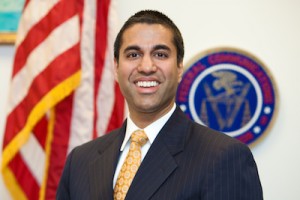 FCC Commissioner Ajit Pai
FCC Commissioner Ajit Pai
Last week, the FCC passed an order accelerating its text-to-911 roll out by requiring all carriers, as well as certain dedicated texting apps, to support text-to-911 by the end of the year. However, two members of the commission, Ajit Pai and Michael O'Reilly, dissented from the order, suggesting that because the public safety answering points (PSAPs) that process 911 calls aren't moving at the same pace as carriers, the order won't have much affect -- and could even be detrimental as people try to text 911 in areas where the technology isn't in place.
Making 911 services available via text messaging has been a priority of the FCC for a number of years. It makes emergency services more available for deaf or non-speaking people, allows people who are in immediate danger to discreetly contact emergency services, and can be used by choking victims or others for whom the nature of an emergency also makes it difficult for them to speak. At the end of 2012, the four largest wireless carriers, AT&T, Sprint, Verizon Wireless, and T-Mobile USA, agreed voluntarily to have the service ready by May 2014, which they have now done.
This order requires the remaining, smaller carriers to follow suit, and further applies to any text message provider that allows users to text to and from US phone numbers. Starting at the end of the year, it gives carriers six months to comply if a local 911 call center asks them to provide messaging services. It will also require providers to set up bounce back messages that will inform people in areas without text-to-911 that they have to call. Text to 911 is currently up and running in 100 call centers, including all over the states of Vermont and Maine.
"We know that text-to-911, where it is available, is a lifesaver," FCC Chairman Tom Wheeler wrote in a statement. "In Hamilton County, Ohio, a young woman was contemplating suicide, and a friend urged her to call for help. She didn’t want her parents to hear her on the phone, though, so she texted instead, and received counseling that may have saved her life. In Collier County, Florida, which only recently started supporting text-to-911, a woman was having a medical emergency and called 911 three times, but was unable to speak. She then texted, 'Help me,' and first responders were finally dispatched. And in Vermont, which supports texting statewide, a woman was injured while hiking alone on a remote trail. Although cell phone coverage was not good enough for her to make a voice call, she was able to text 911 and through that exchange direct first responders to her location."
Commissioners Mignon Clyburn and Jessica Rosenworcel joined Wheeler in supporting the order. But Pai and O'Reilly feel that the order puts the cart before the horse in a number of unacceptable ways.
"[T]here can be tragic consequences when 911 technologies do not match up with consumer expectations," Pai wrote in his dissenting statement. "Unfortunately, that’s the case with this order. It encourages the public to dive into text-to-911 functionality when in reality there’s hardly any water in the pool. Because I believe the order is sure to result in massive consumer confusion, and therefore will endanger rather than advance public safety, I respectfully dissent."
Pai points out that because the call centers, which are operated by state and local governments, have largely not upgraded to support text-to-911, currently it is only available in less than 2 percent of the country, despite that the four mobile operator that are already onboard cover 90 percent of the country. As such, he suggests the order will serve more to "generate feel good headlines" than to actually advance care. And he said when the American public thinks they can text 911, but in fact cannot, it will lead to dangerous delays.
"To be sure, we need to ensure that our 911 rules keep pace with changes in technology and consumer usage," he wrote. "But we must do so guided by a fundamental principle that dates back to the days of Hippocrates—first, do no harm. This 0rder doesn’t meet this standard. How many Americans will waste precious seconds during an emergency attempting in vain to text 911 because of it—seconds that could make all the difference? I fear that the answer will be too many."
Additionally, there is a question as to whether text message providers that are not wireless carriers even fall under the FCC's regulatory purview. This was a particular point of contention for O'Reilly, who believes the commission has done insufficient work to understand how they can mandate the actions of these text massaging providers.
"The prudent approach would have been to hold back on this portion and address it when this technology was tested and when the other models were available," he wrote. "Alas, we seem committed to moving forward on a predetermined timeline. The phase 'perfection is the enemy of good enough' has been used recently and it makes me cringe to think our work should be measured as just good enough. Don’t we owe the American people more than good enough?"
The FCC is still working on its NextGen 911 project, a separate initiative that will incorporate photos, videos, and data into emergency services and will use data and wifi rather than SMS. This project has been on a five to 10-year timeline since 2012, but Pai believes this renewed focus on text-to-911 could delay that implementation even further.

















